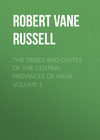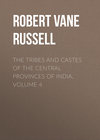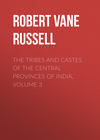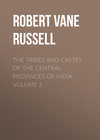Kitabı oku: «The Tribes and Castes of the Central Provinces of India, Volume 1», sayfa 28
2. Nānakpanthis in the Central Provinces
In 1901 about 13,000 persons returned themselves as Nānakpanthis in the Central Provinces, of whom 7000 were Banjāras and the remainder principally Kunbis, Ahīrs and Telis. The Banjāras generally revere Nānak, as shown in the article on that caste. A certain number of Mehtars or sweepers also profess the sect, being attached to it, as to the Sikh religion, by the abolition of caste restrictions and prejudices advocated by their founders; but this tolerance has not been perpetuated, and the unclean classes, such as the Mazbi or scavenger Sikhs, are as scrupulously avoided and kept at a distance by the Sikh as by the Hindu, and are even excluded from communion, and from the rites and holy places of their religion.344
3. Udasis
The Udāsis are a class of ascetics of the Nānakpanthi or Sikh faith, whose order was founded by Sri Chand, the younger son of Nānak. They are recruited from all castes and will eat food from any Hindu. They are almost all celibates, and pay special reverence to the Adi-Granth of Nānak, but also respect the Granth of Govind Singh and attend the same shrines as the Sikhs generally. Their service consists of a ringing of bells and blare of instruments, and they chant hymns and wave lights before the Adi-Granth and the picture of Bāba Nānak. In the Central Provinces members of several orders which have branched off from the main Nānakpanthi community are known as Udāsi. Thus some of them say they do not go to any temples and worship Nirankal or the deity without shape or form, a name given to the supreme God by Nānak. In the Punjab the Nirankaris constitute a separate order from the Udāsis.345 These Udāsis wear a long rope of sheep’s wool round the neck and iron chains round the wrist and waist. They carry half a cocoanut shell as a begging-bowl and have the chameta or iron tongs, which can also be closed and used as a poker. Their form of salutation is ‘Matha Tek,’ or ‘I put my head at your feet.’ They never cut their hair and have a long string of wool attached to the choti or scalp-lock, which is coiled up under a little cap. They say that they worship Nirankal without going to temples, and when they sit down to pray they make a little fire and place ghī or sweetmeats upon it as an offering. When begging they say ‘Alakh,’ and they accept any kind of uncooked and cooked food from Brāhmans.
4. Suthra Shāhis
Another mendicant Nānakpanthi order, whose members visit the Central Provinces, is that of the Suthra Shāhis. Here, however, they often drop the special name, and call themselves simply Nānakshahi. The origin of the order is uncertain, and Sir E. Maclagan gives various accounts. Here they say that their founder was a disciple of Nānak, who visited Mecca and brought back the Seli and Syahi which are their distinctive badges. The Seli is a rope of black wool which they tie round their heads like a turban, and Syāhi the ink with which they draw a black line on their foreheads, though this is in fact usually made with charcoal. They carry a wallet in which these articles are kept, and also the two small ebony sticks which they strike against each other as an accompaniment to their begging-songs. The larger stick is dedicated to Nānak and the smaller to the Goddess Kāli. They are most importunate beggars, and say that the privilege of levying a pice (farthing) was given to them by Aurāngzeb. They were accustomed in former times to burn their clothes and stand naked at the door of any person who refused to give them alms. They also have a bahi or account-book in which the gifts they receive, especially from Banias, are recorded. Mr. Crooke states that “They indulge freely in intoxicants and seldom cease from smoking. Their profligacy is notorious, and they are said to be composed mainly of spendthrifts who have lost their wealth in gambling. They are recruited from all castes and always add the title Shāh to their names. A proverb says in allusion to their rapacity:
Kehu mare, Kehu jīye,
Suthra gur batāsa piye;
or, ‘Others may live or die, but the Suthra Shāhi must have his drink of sugar and water.’346
Parmārthi Sect
Parmārthi Sect.—A Vishnuite sect of which 26,000 persons were returned as members in the census of 1901. Nearly all of these belonged to the Uriya State of Kālāhandi, since transferred to Bihār and Orissa. The following account of the sect has been furnished by Rai Bahādur Panda Baijnāth, formerly Diwān of Kālāhandi State.
This sect penetrated the State from the Orissa side, and seems to belong to Bengal. In the beginning it consisted only in pure devotion to the worship of Krishna, but later it has been degraded by sexual indulgence and immorality, and this appears to be the main basis of its ritual at present. Outwardly its followers recite the Bhāgavad Gīta and pretend to be persons of very high morals. Their secret practices were obtained from one of his officials who had entered the sect in the lowest grade. On the day of initiation there is a great meeting of members at the cost of the neophyte. A text is taught to him, and the initiation is completed by all the members partaking together of a feast without distinction of caste. The food eaten at this is considered to be Mahāprasād, or as if offered to Vishnu in his form of Jagannāth at Puri, and to be therefore incapable of defilement. The mantra or text taught to the disciple is as follows:
O Hari, O Krishna, O Hari, O Krishna,
O Krishna, O Krishna, O Hari, O Hari,
O Hari, O Rāmo, O Hari, O Rāmo,
O Rāmo, O Rāmo, O Hari, O Hari.
The disciple is enjoined to repeat this text a prescribed number of times, 108 or more, every day. To those pupils who show their devotional ardour by continual repetition of the first text others are taught.
The next step is that the disciple should associate himself or herself with some other Parmārthi of the opposite sex and tend and serve them. This relation, which is known as Asra-patro, cannot exist between husband and wife, some other person having to be chosen in each case, and it results of course in an immoral connection. Following this is the further rite of Almo-Samarpana or offering of oneself, in which the disciple is required to give his wife to the Guru or preceptor as the acme of self-sacrifice. The guru calls the disciple by a female name of one of the milkmaids of Brindāban to indicate that the disciple regards Krishna with the same devotion as they did. Sometimes the guru and a woman personate Krishna and Rādha, but reverse the names, the guru calling himself Rādha and the woman Krishna. The other disciples wait upon and serve them, and they perform an immoral act in public. Parmārthi women sometimes have the mantra or text, ‘O Hari, O Krishna,’ tattooed on their breasts.
The Parmārthis often deny the accusation of immorality, and the above statements may not be true of all of them; but they are believed to be true as regards a considerable part of the sect at any rate. “With all his cleanliness, vegetarianism and teetotalism,” one writer remarks, “the Vaishnava is perhaps the most dangerous in the whole list of Hindu sects. He has done very good service in civilising the lower classes to some extent and in suppressing the horrors of the Tāntric worship. But the moral laxity which the Vaishnava encourages by the stories of the illicit loves between the God and Goddess, and by the strong tendency to imitate them which his teachings generate, outweigh the good done by him.” This statement applies, however, principally to one or two sects devoted to Krishna, and by no means to all nor to the majority of the Vaishnava sects.
Pārsi or Zoroastrian Religion
[Bibliography of works quoted: Dr. Martin Haug’s Essays on the Pārsis, Trübner’s Oriental Series; Bombay Gazetteer, vol. ix. part ii., Pārsis of Gujarāt. by the late Mr. Kharsedji Nasarvanji Seervai, J.P., and Khān Bahādur Bāmanji Behrāmji Patel; M. Salomon Reinach’s Orphéus; Rev. J. Murray Mitchell’s Great Religions of India. The whole account of the customs and social life of the Pārsis is taken from the excellent description in the Bombay Gazetteer.]
1. Introductory
The number of Pārsis in the Central Provinces in 1911 was about 1800. They are immigrants from Bombay, and usually reside in large towns, where they are engaged in different branches of trade, especially in the manufacture and vend of liquor and the management of cotton mills and factories.347 The word Pārsi means a resident of the province of Fārs or Pārs in Persia, from which the name of the country is also derived.
2. The Zoroastrian religion
Also known as Mazdaism, the Zoroastrian religion was that of the ancient Magi or fire-worshippers of Persia, mentioned in Scripture. It is supposed that Zoroaster or Spitama Zarathustra, if he was a historical personage, effected a reformation of this religion and placed it on a new basis at some time about 1100 B.C. It is suggested by Haug348 that Zarathustra was the designation of the high priests of the cult, and Spitama the proper name of that high priest who carried out its distinctive reformation, and perhaps separated the religion of the Persian from the Indian Aryans. This would account for the fact that the sacred writings, which, according to the testimony of Greek and Roman authors, were of great extent, their compilation probably extending over several centuries, were subsequently all ascribed to one man, or to Zarathustra alone. The Zend-Avesta or sacred book of the Pārsis does not mention the fire priests under the name of Magi, but calls them Athravan, the same word as the Sanskrit Atharva-Veda. The reason for this, M. Reinach suggests, is that the Magi had rebelled against Cambyses, the son of Cyrus, in the sixth century B.C., during his absence in Egypt, and placed a rival creature of their own on the throne. Darius, the son of Hystaspes, overthrew him and re-established the Persian kingdom in 523 B.C., and this may have discredited the Magian priests and caused those of the reformed religion to adopt a new name.349 It is certain that Cyrus conformed to the precept of the Avesta against the pollution of the sacred element water, when he diverted the course of the river Gyndanes in order to recover the body of a horse which had been drowned in it, and that Darius I. invokes in his inscriptions Ormazd or Ahura Mazda, the deity of the Avesta.350 On the subversion of the Persian empire by Alexander, and the subsequent conquest of Persia by the Arsacid Parthian dynasty, the religion of the fire-worshippers fell into neglect, but was revived on the establishment of the Sassanian dynasty of Ardeshir Bābegan or Artaxerxes in A.D. 226, and became the state religion, warmly supported by its rulers, until the Arab conquest in A.D. 652. It was at the beginning of this second period of prosperity that the Zend-Avesta as it still exists was collected and reduced to writing, but it is thought that the greater part of the remains of the ancient texts recovered at the time were again lost during the Arab invasion, as the original literature is believed to have been very extensive.
3. The Zend-Avesta
The language of the Zend-Avesta is the ancient east Iranian or Bactrian dialect, which probably died out finally in the third century B.C., modern Persian being descended from the west Iranian or Median tongue. The Bactrian language of the Zend-Avesta is, Haug states, a genuine sister of Sanskrit, Greek, Latin and Gothic. “The relationship of the Avesta language to the most ancient Sanskrit, the so-called Vedic dialect, is as close as that of the different dialects of the Greek language, Aeolic, Ionic, Doric or Attic, to each other. The languages of the sacred hymns of the Brāhmans, and of those of the Pārsis, are only the two dialects of two separate tribes of one and the same nation. As the Ionians, Dorians, Aetolians, etc., were different tribes of the Greek nation whose general name was Hellenes, so the ancient Brāhmans and Pārsis were two tribes of the nation which is called Aryas both in the Veda and Zend-Avesta.”351 The sections of the Zend-Avesta which remain are about equal in size to the Bible. They consist of sacrificial hymns, prayers and accounts of the making of the world, in the form of conversations between Ahura Mazda and Zoroaster. The whole arrangement is, however, very fragmentary and chaotic, and much of the matter is of a trivial character. It cannot be compared in merit with the Old Testament.
4. The Zend Avesta and the Vedas
A cuneiform inscription discovered in the centre of Asia Minor at Ptorium proves that about 1400 B.C. certain tribes who had relations with the Hittite empire had for their deities Mitra, Indra, Varūna and the Nasātyas. The first two names are common to the Persian and Indian Aryans, while the last two are found only in India. It appears then that at this time the ancestors of the Hindus and Iranians were not yet separated.352 Certain important contrasts between the ancient Zoroastrian and Vedic religions have led to the theory that the separation was the result of a religious and political schism. The words Deva and Asura have an exactly opposite significance in the two religions. Deva353 is the term invariably used for the gods of the Hindus in the whole Vedic and Brahmānical literature. In the Zend-Avesta, on the other hand, Deva (Pers. div) is the general name of an evil spirit, a fiend, demon or devil, who is inimical to all that is good and comes from God. The part of the Avesta called the Vendidād, consisting of a collection of spells and incantations, means vī-daevo-dāta or given against the Devas or demons. The Devas, Dr. Haug states, are the originators of all that is bad, of every impurity, of death; and are constantly thinking of causing the destruction of the fields and trees, and of the houses of religious men. “Asura, occurring as Ahura in the first part of Ahura-Mazda (Hormazd), is the name of God among the Pārsis; and the Zoroastrian religion is distinctly called the Ahura religion, in strict opposition to the Deva religion. But among the Hindus Asura has assumed a bad meaning, and is applied to the bitterest enemies of their Devas (gods), with whom the Asuras are constantly waging war. This is the case throughout the whole Purānic literature and as far back as the later parts of the Vedas; but in the older parts of the Rig-Veda Sanhita we find the word Asura used in as good and elevated a sense as in the Zend-Avesta. The chief gods, such as Indra, Varūna, Agni, Savitri, Rudra or Siva, are honoured with the epithet ‘Asura,’ which means ‘living, spiritual,’ and signifies the divine in its opposition to human nature.
“In a bad sense we find Asura only twice in the older parts of the Rig-Veda, in which passages the defeat of the ‘sons or men of the Asura’ is ordered or spoken of; but we find the word more frequently in this sense in the last book of the Rig-Veda (which is only an appendix to the whole made in later times), and in the Atharva-Veda, where the Rishis are said to have frustrated the tricks of the Asuras and to have the power of putting them down. In the Brāhmanas or sacrificial books belonging to each of the Vedas we find the Devas always fighting with the Asuras. The latter are the constant enemies of the Hindu gods, and always make attacks upon the sacrifices offered by devotees. To defeat them, all the craft and cunning of the Devas were required; and the means of checking them was generally found in a new sacrificial rite.”354
Professor Haug adduces other arguments in this connection from resemblance of metres. Again the principal Vedic God, Indra, is included in the list of Devas or demons in the Zoroastrian scripture, the Vendidād. Siva and the Nasātyas or Ashvins, the divine horsemen of the Vedas, are also said to be found in the list of Devas or demons. Others of the Vedic gods as Mitra the sun, Aryaman, either another name for the sun or his constant associate and representative, Vayu the wind, and one or two more are found as Yazatas or angels in the Zend-Avesta.355
5. Reasons for the schism between the Persian and Indian Aryans
Professor Haug’s suggestion as to the cause of the schism between the Iranian and Indian branches of the Aryans is very interesting. He thinks that the Aryan tribes after they had left their original home, which was in all likelihood a cold country, led mainly a pastoral life, and cultivated only occasionally some patches of land for their own support. But when they arrived in the tract between the Oxus and Jaxartes rivers, and the highlands of Bactria, which were suitable for permanent settlement, certain of them, who were the ancestors of the Iranian branch, forsook the pastoral life of their ancestors and became agriculturists. Others, the ancestors of the Indian Aryans, retained their nomadic habits, and took to the practice of making predatory incursions into the territories of the settled communities. Hence arose a bitter hostility between them; and as the success of the raiders was attributed to their religious spells and incantations, and especially to the consumption of the Soma liquor under the auspices of the God Indra, this part of their joint religion became hateful to the Iranians and led to the founding of the reformed Zoroastrian religion, in which special stress is laid on the virtue obtained from bringing land under cultivation, making enclosures and permanent settlements and protecting agricultural cattle. This is forcibly expressed in the saying, ‘He who cultivates barley cultivates righteousness,’ and others.356 Finally the nomadic tribes left the common residence in the Central Asian highlands and migrated into India. It is not certain that scholars generally accept the above hypothesis.
6. The dual principles and the conflict between good and evil
The most prominent feature of the religion of Zarathustra is the dual principle of good and evil and the conflict between them. Ahura Mazda is the supreme deity, the creator of the world, and Ahriman or Angro Mainyush is the evil one, his constant opponent. A perpetual struggle proceeds between them, extending over the whole of creation, and will continue for a period of 12,000 years. The virtuous lives and prayers and sacrifices of men help the cause of Ahura Mazda, while every bad action and all kinds of ceremonial impurity constitute an assistance rendered by them to Ahrimān. Not only virtue, courage, charity humility and kindness to animals, when displayed by men, are held to reinforce Ahura Mazda, but also such useful acts as cleaning a field for cultivation, digging a canal or building a bridge. The animals are also divided into good and bad, the latter being considered the creation of Ahrimān and designated the seed of the serpent. The bad animals include tigers, snakes, cats, wolves, frogs, mice, ants and others, and to kill them is to perform a virtuous act in the cause of Ahura Mazda. Among good animals dogs and agricultural cattle appear to be the chief. The division is very imperfect, and it would seem that the classification does not extend to birds and fish. Most trees are good, but their bark is evil. Hail, snow and all kinds of diseases are believed to be the work of Ahrimān and his evil spirits.357 As all ceremonial impurity renders assistance to the evil one, the Pārsis are very careful in such matters, as will be noticed subsequently. Ahura Mazda is assisted in his struggle for the good by six Amesha-Spentas or good spirits, who are something like archangels. They consist of the spirits of cattle, fire, metals, the earth, health and immortality. With the first four of these some moral quality or attribute as truth, wisdom and the curing of diseases is now associated. Another great spirit Sraosha is the judge of the dead. Similarly Ahrimān is assisted by six arch-fiends and a whole host of evil spirits (Deva and Druj) of all kinds, against whom men have to be perpetually on their guard. One of the principal bad spirits is Aeshma Deva, the roaring demon, who appears to be the Asmodeus mentioned in the Apocrypha. At the end of the period of struggle Ahura Mazda will engage in a final contest with Ahrimān and will conquer with the help of the Archangel Sraosha, who will overcome the demon Aeshma. A virgin will then conceive and bring forth the second Zoroaster as a Messiah, who will cause the resurrection of the dead. The good will be separated from the bad, but the punishment of the latter will not be eternal; and after the purification of the world by a general conflagration all humanity will unite in the adoration of Ahura Mazda.358 Meanwhile after death the souls of all men are weighed and have to pass over a narrow bridge called Chinvad. The good souls, lightened by the absence of sin, find it a broad and easy path to heaven, while to the bad ones, weighed down with their sins, it becomes narrow as a razor’s edge, and they fall over into hell. M. Salomon Reinach points out that their beliefs have several points of resemblance with those of Judaism, but it is not easy to say which religion has borrowed from the other.359 The word paradise, according to Dr. Haug, comes from pairidaesa in the Zend-Avesta and means a park or beautiful garden protected by a fence.



